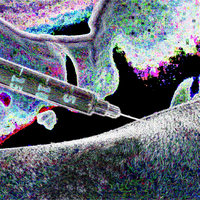| Lidocaine | |
|---|---|
| Salts [] | |
|---|---|
| Lidocaine carbonate | |
| Lidocaine tosylate | |
| Lidocaine bicarbonate | |
| Lidocaine iminodiacetic acid | |
| Lidocaine maleate | |
| Lidocaine hydrochloride | |
| Lidocaine sulfate | |
| Molecular structure via molpic based on CDK |
| Rotamer [] | |
|---|---|
| Conformer structure via 3Dmol.js |
| Physical properties [] | |
|---|---|
| Molecular mass | 234.34 g/mol [1] |
| Appearance | Needles from benzene or alcohol [1] |
| Odor | Characteristic odor [1] |
| Melting point | 68 °C [1] |
| Boiling point | 159-160 °C at 2.00E+00 mm Hg [1] |
| Decomposition | When heated to decomposition it emits toxic fumes of /nitrogen oxides/. [1] |
| Solubility | VERY SOL IN ALC; SOL IN CHLOROFORM; INSOL IN ETHER; WHITE CRYSTALLINE POWDER /LIDOCAINE HYDROCHLORIDE/ [1] |
| Predicted LogP | 2.3 [1] |
| Structural Identifiers [] | |
|---|---|
| Molecular formula | C14H22N2O [1] |
| IUPAC name | 2-(diethylamino)-N-(2,6-dimethylphenyl)acetamide [1] |
| SMILES | CCN(CC)CC(=O)NC1=C(C=CC=C1C)C [1] |
| InChI | InChI=1S/C14H22N2O/c1-5-16(6-2)10-13(17)15-14-11(3)8-7-9-12(14)4/h7-9H,5-6,10H2,1-4H3,(H,15,17) [1] |
| InChIKey | NNJVILVZKWQKPM-UHFFFAOYSA-N [1] |
| Pharmacokinetics[] | |
|---|---|
| Elimination half-life | 1.5 h - 2 h |
| Duration of action | 10 min - 20 min (IV), 0.5 h - 3 h (local) |
Lidocaine
Lidocaine is a sodium channel blocker substance of the aniline class.
Chemistry
Salts []
Lidocaine is typically found in the form of its carbonate, tosylate, bicarbonate, iminodiacetic acid, maleate, hydrochloride and sulfate salts.
Stereochemistry []
Lidocaine is a achiral mixture
Pharmacology
Interactions
- CYP3A4 induction
- CYP3A4 inhibition
- CYP1A2 induction
- CYP3A4 inhibitioninduction
- CYP1A2 inhibitioninduction
- CYP1A2 inhibition
| Anodyne Usernotes [] | |
|---|---|
| 0xea / Lidocaine[freebase] via Topical |
|
Legal status
- Australia: Lidocaine is a S5, S4, and S2 substance.[3]
- Canada: Lidocaine is a prescription only substance.
- United Kingdom: Lidocaine is a GSL, P, and prescription only substance.
- United States: Lidocaine is a prescription only substance.
See also []
External links []
References []
National Center for Biotechnology Information. PubChem Compound Summary for CID 3676, Lidocaine. Accessed December 20, 2025. https://pubchem.ncbi.nlm.nih.gov/compound/3676
U.S. Food and Drug Administration; National Center for Advancing Translational Sciences. Lidocaine. UNII: 98PI200987. Global Substance Registration System. Accessed December 20, 2025. https://gsrs.ncats.nih.gov/ginas/app/beta/substances/98PI200987
Poisons Standard February 2021. January 1, 2021. Accessed December 20, 2025. https://www.legislation.gov.au/Details/F2021C00098
 Anodyne
Anodyne